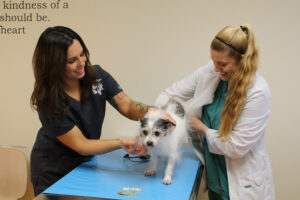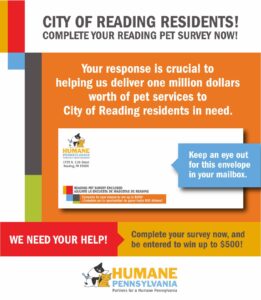By: Jacqueline L. Connolly, DVM for Humane Veterinary Hospitals
Lyme disease is caused by the spirochete bacteria, Borrelia burgdorferi, and is transmitted through the bite of infected ticks. Not only is this disease one of the most common tick-borne illnesses in the United States, but it is also zoonotic – meaning it can infect both humans and animals. According to The Centers of Disease Control and Prevention (CDC), a large number of reported cases are in the northeast region, putting our furry family members in Pennsylvania at a greater risk.
Lyme disease is most commonly transmitted by the black legged tick (Ixodes species), after prolonged feeding (>24-28 hours). Over the span of 2-5 months, the bacteria will migrate to the skin, muscle, joints, lymph nodes and kidneys which can result in serious illness. Therefore, tick prevention is the key to keeping our pets protected and Lyme disease free.
Clinical Signs 
Clinical Signs of Lyme disease vary with the patient and the stage of the disease. Initial infections may cause fever, lethargy, anorexia, lymph node enlargement, and muscle and joint pain. Many pet owners will notice limping, a reluctance to move, and joints that are warm to the touch. In more serious and chronic infections, the bacteria can infect the kidneys, causing ‘Lyme nephritis’ or kidney failure. Some studies suggest this may occur more often in Golden retrievers and Labradors.
Once infected with Lyme disease, dogs generally remain infected for life and can have continued flare-ups that require treatment. Others may never show clinical signs, or may even clear the infection on their own.
So when do we test and treat for Lyme? This has been a controversial subject in veterinary medicine.
Testing
If your pet has shown any of the clinical signs of Lyme disease your veterinarian will order a blood test to determine if he/she is Lyme positive. One of the commonly used tests is a SNAP 4DX, which also screens for heartworm disease and two other tick borne illnesses. This test is generally done at every annual exam to ensure your pet is healthy and on proper prevention.
If your dog is Lyme positive, a urine test and comprehensive blood test may be advised. This is an important step in making sure your pet does not have a more serious form of Lyme disease, Lyme nephritis.
To Treat or Not To Treat
Treatment is not always recommended for Lyme positive dogs. If your dog is showing clinical signs, your veterinarian will prescribe a 3-4 week course of an antibiotic such as Doxycycline. In more severe cases, your veterinarian may also prescribe medications for pain. Symptoms of Lyme disease should resolve within the first week of treatment.
In non-clinical cases, your veterinarian will recommend additional tests to determine kidney function. If your dog has protein in his/her urine, or evidence of kidney dysfunction, antibiotics will be prescribed. If laboratory tests are all normal, your veterinarian will continue monitoring with yearly physical examinations and bloodwork.
The general consensus at this time, is that treatment with antibiotics in pets that are asymptomatic is not necessary. Treatment may put your dog at risk of possible side effects from the antibiotic, such as vomiting and diarrhea, with little benefit. As medical professionals, we take antibiotic resistance very seriously, and do not want to overuse these medications when they are not needed.
Prevention
Keeping your dog protected from ticks year round is the best way to prevent Lyme disease. There are many products on the market including topical and chewable monthly preventatives and collars. Some products are more effective than others, which is why it is important to speak with your veterinarian about which products work best.
For patients at a greater risk of contracting the disease, your veterinarian will give a yearly Lyme vaccine. High risk patients include dogs that live in endemic areas (northeast region), those with outdoor lifestyles, and those who frequently visit wooded areas such as with hiking, camping, or hunting.
Checking your dog for ticks can help limit the amount of time a tick is on your pet, and therefore decreases the probability of transmission. Black legged ticks can be very small and hard to find especially if in the groin, between the toes, inside the ears, or under the tail. A thorough check of both yourself and your pet should be conducted when coming in from outside.
At Humane Veterinary Hospitals we understand your pet is a member of your family. Please make an appointment if you have any additional questions regarding your pet and Lyme disease. It is our goal to keep your pet healthy and free from disease for many years to come.


 model now, but it helped kill off Blockbuster.
model now, but it helped kill off Blockbuster.